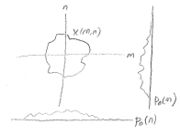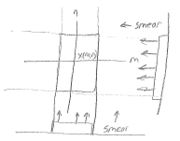Communication Networks Signal and Image processing (CS)
Problem 1,2
Solution 1:
a)
$ {{P}_{0}}({{e}^{j\omega }})=\sum\limits_{n=-\infty }^{\infty }{{{p}_{0}}(n){{e}^{-jn\omega }}}=\sum\limits_{n=-\infty }^{\infty }{\left( \sum\limits_{m=-\infty }^{\infty }{x(m,n)} \right){{e}^{-jn\omega }}}=\sum\limits_{m=-\infty }^{\infty }{\sum\limits_{n=-\infty }^{\infty }{x(m,n)}{{e}^{-j(m0+n\omega )}}=X({{e}^{j0}},{{e}^{j\omega }})} $
b)
$ {{P}_{1}}({{e}^{j\omega }})=\sum\limits_{m=-\infty }^{\infty }{{{p}_{1}}(m){{e}^{-jm\omega }}}=\sum\limits_{m=-\infty }^{\infty }{\left( \sum\limits_{n=-\infty }^{\infty }{x(m,n)} \right){{e}^{-jm\omega }}}=\sum\limits_{m=-\infty }^{\infty }{\sum\limits_{n=-\infty }^{\infty }{x(m,n)}{{e}^{-j(m\omega +n0)}}=X({{e}^{j\omega }},{{e}^{j0}})} $
c)
$ \sum\limits_{n=-\infty }^{\infty }{{{p}_{0}}(n)}==\sum\limits_{n=-\infty }^{\infty }{\left( \sum\limits_{m=-\infty }^{\infty }{x(m,n)} \right)}=\sum\limits_{m=-\infty }^{\infty }{\sum\limits_{n=-\infty }^{\infty }{x(m,n)}{{e}^{-j(m0+n0)}}=X({{e}^{j0}},{{e}^{j0}})} $
d)
No, they don’t. From part (a) and (b), we know that $ {{P}_{0}}({{e}^{jw}}) $ and $ {{P}_{1}}({{e}^{jw}}) $ represent the horizontal and vertical axes of the 2D DSFT $ X({{e}^{j\mu }},{{e}^{j\upsilon }}) $, which is not enough for reconstruction of x(m, n). For example, $ {{x}_{1}}(m,n)=\left( \begin{matrix} 1 & 3 \\ 2 & 4 \\ \end{matrix} \right),_{{}}^{{}} and\ {{x}_{2}}(m,n)=\left( \begin{matrix} 0 & 4 \\ 3 & 3 \\ \end{matrix} \right) $ have the same $ {{p}_{0}}(n)=\left[ \begin{matrix} 3 & 7 \\ \end{matrix} \right]\ and\ {{p}_{1}}(m)=\left[ \begin{matrix} 4 \\ 6 \\ \end{matrix} \right] $. So, x(m,n) can’t be reconstructed from $ {{p}_{0}}(n)=\left[ \begin{matrix} 3 & 7 \\ \end{matrix} \right]\ and\ {{p}_{1}}(m)=\left[ \begin{matrix} 4 \\ 6 \\ \end{matrix} \right] $.
Solution 2:
a)
$ {{P}_{0}}({{e}^{j\omega }})=\sum\limits_{n=-\infty }^{\infty }{\sum\limits_{m=-\infty }^{\infty }{x(m,n)} {{e}^{-jn\omega }}}=X({{e}^{j0}},{{e}^{j\omega }}) $
Multiple steps are skipped in this solution, which are necessary for clarity.
b)
$ {{P}_{1}}({{e}^{j\omega }})=\sum\limits_{m=-\infty }^{\infty }{\sum\limits_{n=-\infty }^{\infty }{x(m,n)}{{e}^{-jm\omega }}}=X({{e}^{j\omega }},{{e}^{j0}}) $
Multiple steps are skipped in this solution, which are necessary for clarity.
c)
They do not; $ {{p}_{0}}(n)\ and\ {{p}_{1}}(m) $ are projections at two angles, and do not contain enough information to reconstruct x(m,n).
$ \begin{align} & X({{e}^{j\mu }},{{e}^{j\upsilon }})=\sum\limits_{m=-\infty }^{\infty }{\left[ \sum\limits_{n=-\infty }^{\infty }{x(m,n)} \right]}{{e}^{-jm\mu }}{{e}^{-jn\upsilon }} \\ & X({{e}^{j\mu }},{{e}^{j\upsilon }})\ne \sum\limits_{m=-\infty }^{\infty }{{{p}_{1}}(m)}{{e}^{-jm\mu }}{{e}^{-jn\upsilon }}\ne {{P}_{1}}({{e}^{j\mu }}){{e}^{-jn\upsilon }} \\ & \Rightarrow Can't\ do\ it! \end{align} $
- To form reconstruction, need projections along many angles.
- Could reconstruct a very simple object, like triangle.
The question asks a counter example if p0(n) and p1(m) don't contain sufficient information to reconstruct the function x(m,n).
Related Problem
Consider the 2D discrete space signal x(m,n) with the DSFT of X(ejμ,ejν) given by
$ X(e^{j\mu},e^{j\nu}) = \sum_{m=-\infty}^{\infty} \sum_{n=-\infty}^{\infty} x(m,n)e^{-j(m\mu+n\nu)} $
Then define
$ p_{0}(n) = \sum_{m=-\infty}^{\infty}x(m,n) $
$ p_{1}(m) = \sum_{n=-\infty}^{\infty}x(m,n) $
with corresponding DTFT given by
$ P_{0}(e^{j\omega}) = \sum_{n=-\infty}^{\infty} p_{0}(n)e^{-jn\omega} $
$ P_{1}(e^{j\omega}) = \sum_{m=-\infty}^{\infty} p_{0}(m)e^{-jm\omega} $
a) Derive an expression for P0(ejω) in terms of X(ejμ,wjν).
b) Derive an expression P0(ejω) in terms of X(ejμ,ejν).
c) Find a function x(m,n) that is not zero everywhere such that $ {{p}_{0}}(n)={{p}_{1}}(m)=0 $ for all m and n.
d) Do the function p0(n) and p1(m) together contain sufficient information to uniquely reconstruct the function x(m,n)? Justify your answer.
(Refer to ECE 637 Spring 2015 Exam 1 Problem 2.)



